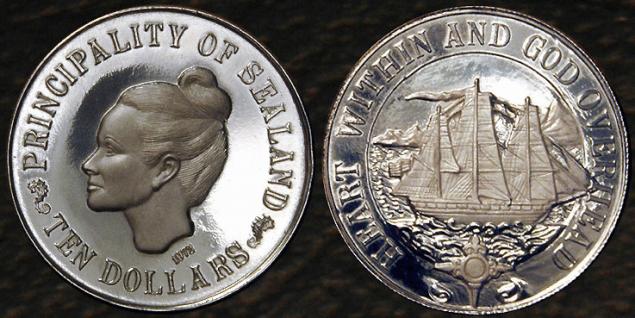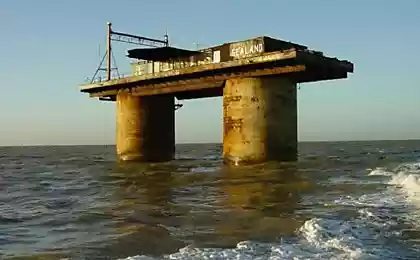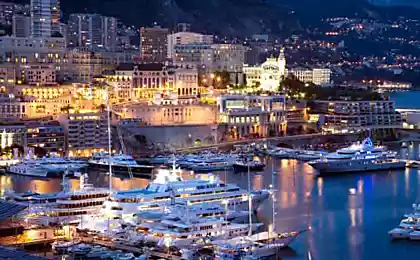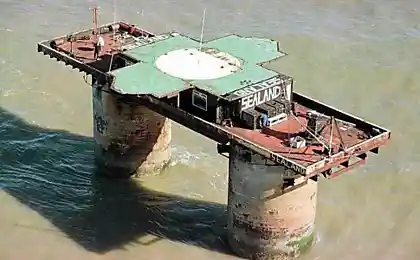416
Principality of Sealand - how to start my own country or how to get out of the matrix
Principality of Sealand — microstran, located on a disused fortification since the Second World war in the North sea, 10 km from the coast of Suffolk in England.

Sealand inhabited by members of the family and friends of a retired British army major paddy Roy Bates, who calls himself not only as "His Royal Highness, Prince Roy Kalendsky". The population of Sealand rarely exceeds five, and its inhabitable area is 550 square meters.
Although the requirements of sovereignty and the legitimacy of Sealand is not recognized by any country, it is still the most famous microstran in the world, which is often cited in debates as an interesting case study of how various principles of international law can be applied to territorial disputes.
In 1943, during world war II, the United Kingdom built several naval FORTS along the coastline to track approaching German bombers. During the construction of the FORTS were in international waters.
The structure consisted of a floating pontoon base with a superstructure of two hollow towers joined by a deck, which could be added other structures. Military the Royal Navy occupied the tower during the war. Being left the Royal Navy in 1956, this artificial island on the high seas was busy pirate radio station before paddy Roy Bates evicted the illegal tenants and himself became a settler.
Initially, paddy Roy Bates wanted to set up his own pirate radio station, but when English laws banned the pirate transmission even outside of British control, he left this idea.
Roy Bates maintained his control over the tower, and on the advice of his lawyer, declared the old Fort a sovereign, independent state, naming it the Principality of Sealand. He designed and raised a new flag, designed a Constitution for Sealand, with the national flag, national anthem, currency and passports.
Shortly after the announcement of Sealand as a sovereign state, he began to issue postage stamps, which were used to forward mail between Sealand and Brussels, Belgium.

Interestingly, a significant amount of mail with stamps of Sealand and the mail was accepted with no extra fees and passed by Belgian postal authorities into the international postal system. Three years later, Sealand minted its first coin of the "Sealand Dollar", which cost was at parity with the U.S. dollar.
Lacking in the real sector of the economy, Sealand became an offshore Internet hosting in late 2000.

Sealand also sells titles of nobility, including Baron, Earl and knight, just 29.99 pounds. Once the Spanish group has started to produce a large number of counterfeit Sealand passports and sold them to Eastern Europeans.
As many as 150,000 passports were in circulation. These passports were not recognized by the family of Bates, who in 1997 had to cancel all Sealand passports, including those that they themselves had produced over the previous thirty years. Instead, Sealand started to accept bookings for tourist visits.
The government of Roy Bates had several confrontations with the British including an incident when Roy's son Michael Bates fired at a British military ship that came too close to the territory of Sealand. But as the incident occurred outside British territorial waters, no charges have ever been filed.

In 1978, while Bates was away, the self-proclaimed Prime Minister of Sealand, Alexander Achenbach, several German and Dutch mercenaries, seized power and held Bates's son hostage.
Roy Bates, with the help of a helicopter and retook the fortress. He kept the invaders at the captives, before reluctant to release them. Deteriorating health forced Roy Bates to move to the mainland in Essex, where for several years he died of Alzheimer's disease, in October 2012, at the age of 91 years.

Between 2007 and 2010, Sealand was offered for sale at a price of $906 million, but did not find buyers, although it was reported that the infamous torrent tracker the Pirate Bay tried to buy Sealand to install servers so they can work in the region outside the jurisdiction of any country.
Source: lifeglobe.net/

Sealand inhabited by members of the family and friends of a retired British army major paddy Roy Bates, who calls himself not only as "His Royal Highness, Prince Roy Kalendsky". The population of Sealand rarely exceeds five, and its inhabitable area is 550 square meters.
Although the requirements of sovereignty and the legitimacy of Sealand is not recognized by any country, it is still the most famous microstran in the world, which is often cited in debates as an interesting case study of how various principles of international law can be applied to territorial disputes.
In 1943, during world war II, the United Kingdom built several naval FORTS along the coastline to track approaching German bombers. During the construction of the FORTS were in international waters.
The structure consisted of a floating pontoon base with a superstructure of two hollow towers joined by a deck, which could be added other structures. Military the Royal Navy occupied the tower during the war. Being left the Royal Navy in 1956, this artificial island on the high seas was busy pirate radio station before paddy Roy Bates evicted the illegal tenants and himself became a settler.
Initially, paddy Roy Bates wanted to set up his own pirate radio station, but when English laws banned the pirate transmission even outside of British control, he left this idea.
Roy Bates maintained his control over the tower, and on the advice of his lawyer, declared the old Fort a sovereign, independent state, naming it the Principality of Sealand. He designed and raised a new flag, designed a Constitution for Sealand, with the national flag, national anthem, currency and passports.
Shortly after the announcement of Sealand as a sovereign state, he began to issue postage stamps, which were used to forward mail between Sealand and Brussels, Belgium.

Interestingly, a significant amount of mail with stamps of Sealand and the mail was accepted with no extra fees and passed by Belgian postal authorities into the international postal system. Three years later, Sealand minted its first coin of the "Sealand Dollar", which cost was at parity with the U.S. dollar.
Lacking in the real sector of the economy, Sealand became an offshore Internet hosting in late 2000.

Sealand also sells titles of nobility, including Baron, Earl and knight, just 29.99 pounds. Once the Spanish group has started to produce a large number of counterfeit Sealand passports and sold them to Eastern Europeans.
As many as 150,000 passports were in circulation. These passports were not recognized by the family of Bates, who in 1997 had to cancel all Sealand passports, including those that they themselves had produced over the previous thirty years. Instead, Sealand started to accept bookings for tourist visits.
The government of Roy Bates had several confrontations with the British including an incident when Roy's son Michael Bates fired at a British military ship that came too close to the territory of Sealand. But as the incident occurred outside British territorial waters, no charges have ever been filed.

In 1978, while Bates was away, the self-proclaimed Prime Minister of Sealand, Alexander Achenbach, several German and Dutch mercenaries, seized power and held Bates's son hostage.
Roy Bates, with the help of a helicopter and retook the fortress. He kept the invaders at the captives, before reluctant to release them. Deteriorating health forced Roy Bates to move to the mainland in Essex, where for several years he died of Alzheimer's disease, in October 2012, at the age of 91 years.

Between 2007 and 2010, Sealand was offered for sale at a price of $906 million, but did not find buyers, although it was reported that the infamous torrent tracker the Pirate Bay tried to buy Sealand to install servers so they can work in the region outside the jurisdiction of any country.
Source: lifeglobe.net/























